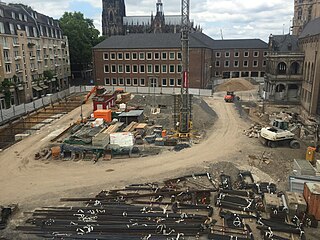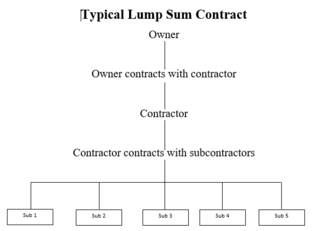A turnkey, a turnkey project, or a turnkey operation is a type of project that is constructed so that it can be sold to any buyer as a completed product. This is contrasted with build to order, where the constructor builds an item to the buyer's exact specifications, or when an incomplete product is sold with the assumption that the buyer would complete it.

Construction is a general term meaning the art and science of forming objects, systems, or organizations. It comes from the Latin word constructio and Old French construction. To 'construct' is a verb: the act of building, and the noun is construction: how something is built or the nature of its structure.
Design–build, also known as alternative delivery, is a project delivery system used in the construction industry. It is a method to deliver a project in which the design and construction services are contracted by a single entity known as the design–builder or design–build contractor. It can be subdivided into architect-led design–build and contractor-led design–build.
Project delivery methods defines the characteristics of how a construction project is designed and built and the responsibilities of the parties involved in the construction. They are used by a construction manager who is working as an agent to the owner or by the owner itself to carry-out a construction project while mitigating the risks to the scope of work, time, budget, quality and safety of the project. These risks ranges from cost overruns, time delays and conflict among the various parties.
Design–bid–build, also known as Design–tender, traditional method, or hardbid, is a project delivery method in which the agency or owner contracts with separate entities for the design and construction of a project.
A general contractor, main contractor, prime contractor, builder (UK/AUS), or contractor is responsible for the day-to-day oversight of a construction site, management of vendors and trades, and the communication of information to all involved parties throughout the course of a building project. In the USA a builder may be a sole proprietor managing a project and performing labor or carpentry work, have a small staff, or may be a very large company managing billion dollar projects. Some builders build new homes, some are remodelers, some are developers.
A management contract is an arrangement under which operational control of an enterprise is vested by contract in a separate enterprise that performs the necessary managerial functions in return for a fee. Management contracts involve not just selling a method of doing things but actually doing them. A management contract can involve a wide range of functions such as technical operation of a production facility, management of personnel, accounting, marketing services, and training.
In the United States, the processes of government procurement enable federal, state and local government bodies in the country to acquire goods, services, and interests in real property. Contracting with the federal government or with state and local public bodies enables interested businesses to become suppliers in these markets.
A cost estimate is the approximation of the cost of a program, project, or operation. The cost estimate is the product of the cost estimating process. The cost estimate has a single total value and may have identifiable component values.
Lean construction is a combination of operational research and practical development in design and construction with an adoption of lean manufacturing principles and practices to the end-to-end design and construction process. Unlike manufacturing, construction is a project-based production process. Lean Construction is concerned with the alignment and holistic pursuit of concurrent and continuous improvements in all dimensions of the built and natural environment: design, construction, activation, maintenance, salvaging, and recycling. This approach tries to manage and improve construction processes with minimum cost and maximum value by considering customer needs.
Project engineering includes all parts of the design of manufacturing or processing facilities, either new or modifications to and expansions of existing facilities. A "project" consists of a coordinated series of activities or tasks performed by engineers, designers, drafters and others from one or more engineering disciplines or departments. Project tasks consist of such things as performing calculations, writing specifications, preparing bids, reviewing equipment proposals and evaluating or selecting equipment and preparing various lists, such as equipment and materials lists, and creating drawings such as electrical, piping and instrumentation diagrams, physical layouts and other drawings used in design and construction. A small project may be under the direction of a project engineer. Large projects are typically under the direction of a project manager or management team. Some facilities have in house staff to handle small projects, while some major companies have a department that does internal project engineering. Large projects are typically contracted out to engineering companies. Staffing at engineering companies varies according to the work load and duration of employment may only last until an individual's tasks are completed.
Construction bidding is the process of submitting a proposal (tender) to undertake, or manage the undertaking of a construction project. The process starts with a cost estimate from blueprints and material take offs.
Construction law is a branch of law that deals with matters relating to building construction, engineering, and related fields. It is in essence an amalgam of contract law, commercial law, planning law, employment law and tort. Construction law covers a wide range of legal issues including contract, negligence, bonds and bonding, guarantees and sureties, liens and other security interests, tendering, construction claims, and related consultancy contracts. Construction law affects many participants in the construction industry, including financial institutions, surveyors, quantity surveyors, architects, carpenters, engineers, construction workers, and planners.
Construction cost estimating software is computer software designed for contractors to estimate construction costs for a specific project. A cost estimator will typically use estimating software to estimate their bid price for a project, which will ultimately become part of a resulting construction contract. Some architects, engineers, construction managers, and others may also use cost estimating software to prepare cost estimates for purposes other than bidding such as budgeting and insurance claims.
Fast-track building construction is construction industry jargon for a project delivery strategy to start construction before the design is complete. The purpose is to shorten the time to completion.
Capital program management software (CPMS) refers to the systems that are currently available that help building owner/operators, program managers, and construction managers, control and manage the vast amount of information that capital construction projects create. A collection, or portfolio of projects only makes this a bigger challenge. These systems go by different names: capital project management software, construction management software, project management information systems.
Pre-construction services are services that are offered to support owners, architects, and engineers in making decisions. They are used in planning a construction project before the actual construction begins. The stage where these services are offered is called pre-construction or "pre-con".
Australian Construction Contracts govern how the parties to a construction contract behave and how the project manager and the contract manager administer the relationship between the parties. There are several popular standard forms of construction contracts that are currently used in Australia.
A construction contract is a mutual or legally binding agreement between two parties based on policies and conditions recorded in document form. The two parties involved are one or more property owners and one or more contractors. The owner, often referred to as the 'employer' or the 'client', has full authority to decide what type of contract should be used for a specific development to be constructed and to set out the legally-binding terms and conditions in a contractual agreement. A construction contract is an important document as it outlines the scope of work, risks, duration, duties, deliverables and legal rights of both the contractor and the owner.

A lump sum contract in construction is one type of construction contract, sometimes referred to as stipulated-sum, where a single price is quoted for an entire project based on plans and specifications and covers the entire project and the owner knows exactly how much the work will cost in advance. This type of contract requires a full and complete set of plans and specifications and includes all the indirect costs plus the profit and the contractor will receive progress payments each month minus retention. The flexibility of this contract is very minimal and changes in design or deviation from the original plans would require a change order paid by the owner. In this contract the payment is made according to the percentage of work completed. The lump sum contract is different from guaranteed maximum price in a sense that the contractor is responsible for additional costs beyond the agreed price, however, if the final price is less than the agreed price then the contractor will gain and benefit from the savings.



